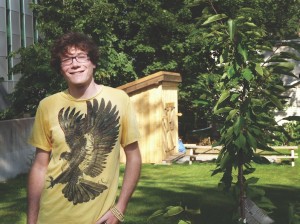
Where the fruit trees grow
New campus garden space to replace SeeMore Green garden
New campus garden space to replace SeeMore Green garden
Rob MacNeish stands proudly beside a cherry tree in the new community garden on Henry Street, behind the Computer Science building. MacNeish, the liaison for the Dalhousie Student Union Sustainability Office (DSUSO), was part of a team that successfully negotiated a long-term green space on campus over the summer.
“We’ve put down trees, which suggests a commitment—trees are not easy to remove,” he says. The sunny garden spot, essentially unused before, now sports a gardening shed, fruit trees and a communal space for growing and learning.
While an official document has yet to be signed between the DSUSO and Dalhousie University, the draft version has a clause in it promising a commitment to garden space in perpetuity.
“What we’re excited about is the connections. We are bringing a lot of people together,” says MacNeish. He explains that the garden will supply food to the Loaded Ladle, perhaps the Gorsebrook Lounge and a nearby food bank, all grown by Haligonians.
“I’m coining the term ‘hyper-local,’” he says.
The DSUSO funded the majority of the project independently. However, they also receive funding through a student levy, and the university supplied 20 per cent of the starting budget and a lot of co-operation to get the project off the ground.
“Facilities management has been really great lending us equipment, helping with red tape and even some money,” MacNeish says. He points out that it’s no longer a fight to get green initiatives happening on campus.
Alexander Gopen, an involved campus gardener, has mixed feelings about the direction in which Dalhousie is taking its green initiatives. “I do think it’s important that students realize what is happening and that it is not as simple as more green space being added.”
Gopen adds that the current garden on Seymour, the “SeeMore Green” garden, is at risk of demolition in the not-too distant future. “I was told 2015 could be the end of SeeMore Green,” he says.
The current version of the Campus Master Plan shows construction behind the Arts Centre, extending to the very edge of the Seymour Street Garden, which MacNeish says doesn’t bode well for the plants.
“Part of the Campus Master Plan is to extend the Cohn, and who knows when that is going to take place. This is essentially a replacement. When the time comes with the bulldozers, and SeeMore is gone, everything is going to be transferred here.”
The Campus Master Plan doesn’t expressly state that SeeMore Green is being removed, but the ‘priority intensification site’ sits on the very edge of the small garden. “Even if it came up just to the border of SeeMore, with them doing large-scale construction, that place is going to go,” says MacNeish.
MacNeish likes the promise of green space in the future, and the location of the new spot. He says he often sees Dal students eating lunch at the new location on Henry Street, as opposed to the hidden SeeMore Green garden.
“That was one of the issues that the university had with [the old] spot. It was essentially a guerrilla garden. They want this to be really bright and shiny.” MacNeish notes that the extra requirements asked of the new location, such as insurance and aesthetics, are not unreasonable.
For MacNeish, the focus is now shifting to the new space and the future of an ongoing green effort. “This place is going to be SeeMore Green 2.0.”







